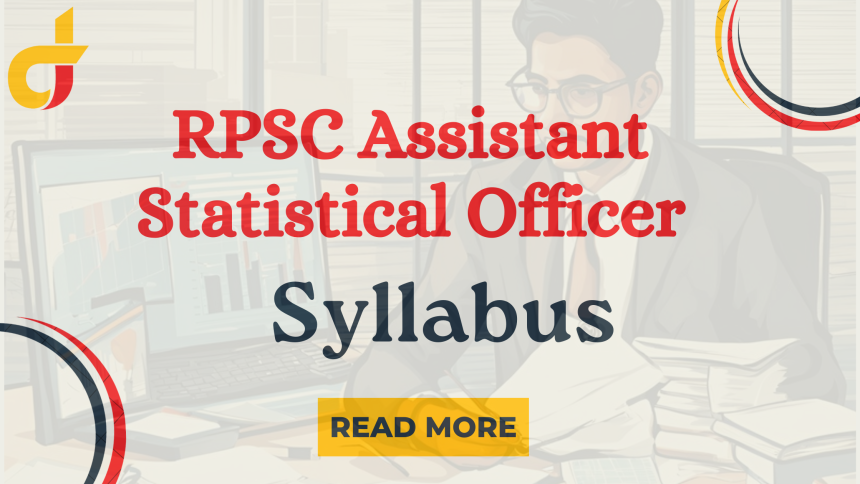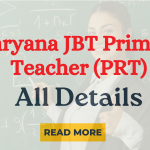राजस्थान लोक सेवा आयोग (RPSC) द्वारा आयोजित सहायक सांख्यिकी अधिकारी (ASO) परीक्षा 2024 के लिए सही तैयारी करना आवश्यक है। इस पोस्ट में हम आपको RPSC सहायक सांख्यिकी अधिकारी परीक्षा के सिलेबस और परीक्षा पैटर्न की सम्पूर्ण जानकारी देंगे, जिससे आप अपनी तैयारी को सही दिशा में ले जा सकें।
राजस्थान सहायक सांख्यिकी अधिकारी 2024 भर्ती की जानकारी
- भर्ती बोर्ड: राजस्थान लोक सेवा आयोग (RPSC)
- पद का नाम: सहायक सांख्यिकी अधिकारी
- रिक्तियों की संख्या: 43
- आवेदन प्रारंभ तिथि: 12 अगस्त, 2024
- आवेदन समाप्ति तिथि: 10 सितंबर, 2024
- आयु सीमा: 18-40 वर्ष
- आवेदन का तरीका: ऑनलाइन
- Advt. No. 09/2024-25
राजस्थान सहायक सांख्यिकी अधिकारी 2024 परीक्षा पैटर्न
RPSC सहायक सांख्यिकी अधिकारी परीक्षा एक लिखित परीक्षा है, जिसमें उम्मीदवारों के ज्ञान और कौशल का आकलन किया जाता है। परीक्षा का पैटर्न निम्नलिखित है:
- परीक्षा का प्रकार: लिखित (Objective Type)
- कुल प्रश्न: 100
- कुल अंक: 100
- समय अवधि: 2 घंटे
- नेगेटिव मार्किंग: प्रत्येक गलत उत्तर के लिए 1/3 अंक की कटौती
परीक्षा में दो मुख्य भाग होते हैं:
- भाग A: राजस्थान का सामान्य ज्ञान (30 अंक)
- भाग B: सांख्यिकी, अर्थशास्त्र और सामान्य जागरूकता (70 अंक)
राजस्थान सहायक सांख्यिकी अधिकारी 2024 सिलेबस का विवरण
राजस्थान लोक सेवा आयोग (RPSC) द्वारा सहायक सांख्यिकी अधिकारी (ASO) परीक्षा 2024 का सिलेबस जारी किया गया है। यह सिलेबस आपको परीक्षा की तैयारी में मदद करेगा। नीचे दिए गए सिलेबस के अनुसार अपनी तैयारी करें।
Part-A: राजस्थान का सामान्य ज्ञान
Unit-I: राजस्थान का इतिहास, संस्कृति और विरासत
- राजस्थान का पूर्व और प्रारंभिक इतिहास
- राजपूतों का काल: राजस्थान के प्रमुख राजवंश और प्रमुख शासकों की उपलब्धियाँ
- आधुनिक राजस्थान का उदय: 19वीं शताब्दी के सामाजिक-राजनीतिक जागरण के कारक
- 20वीं शताब्दी के किसान और आदिवासी आंदोलन
- राजस्थान का राजनीतिक संघर्ष और एकीकरण
- राजस्थान की दृश्य कला: राजस्थान के किलों और मंदिरों की वास्तुकला
- राजस्थान की मूर्तिकला परंपराएँ और चित्रकला शैलियाँ
- राजस्थान की प्रदर्शन कलाएँ: लोक संगीत, वाद्य यंत्र, लोक नृत्य और लोक नाटक
- राजस्थान के धार्मिक पंथ, संत और लोक देवता
- राजस्थान में विभिन्न बोलियाँ और उनका वितरण
- राजस्थानी भाषा का साहित्य
Unit-II: राजस्थान का भूगोल, प्राकृतिक संसाधन और सामाजिक-आर्थिक विकास
- राजस्थान का भूगोल: व्यापक भौतिक विशेषताएँ – पर्वत, पठार, मैदान और रेगिस्तान
- प्रमुख नदियाँ और झीलें
- जलवायु और कृषि-जलवायु क्षेत्र
- प्रमुख मिट्टी के प्रकार और वितरण
- प्रमुख वन प्रकार और वितरण
- जनसांख्यिकीय विशेषताएँ
- मरुस्थलीकरण, सूखा, बाढ़, वनों की कटाई, पर्यावरण प्रदूषण और पारिस्थितिकी संबंधी चिंताएँ
- राजस्थान की अर्थव्यवस्था: प्रमुख खनिज – धातु और गैर-धातु
- ऊर्जा संसाधन: नवीकरणीय और गैर-नवीकरणीय
- प्रमुख कृषि आधारित उद्योग: कपड़ा, चीनी, कागज और वनस्पति तेल
- गरीबी और बेरोजगारी
- कृषि खाद्य पार्क
Unit-III: राजस्थान और भारत की समसामयिक घटनाएँ और मुद्दे
- राज्य के महत्वपूर्ण व्यक्ति, स्थान और समसामयिक घटनाएँ
- राष्ट्रीय और अंतर्राष्ट्रीय स्तर पर महत्वपूर्ण घटनाएँ
- राजस्थान में कल्याण और विकास के लिए नई योजनाएँ और पहल
Part-B: सांख्यिकी, अर्थशास्त्र और सामान्य जागरूकता
(1) Descriptive Statistics
- Classification, tabulation and frequency distribution
- Diagramatic and Graphical Representation: Bar diagram, Pie chart, histogram, frequency polygon, frequency curve
- Measures of central tendency: Arithmetic mean, geometric mean, harmonic mean, median, mode, quartiles, deciles and percentiles
- Measures of Dispersion: Range, quartile deviation, mean deviation, standard deviation, variance, co-efficient of variation, moments, measures of skewness and kurtosis
(2) Probability
- Classical and Axiomatic approaches of probability, Conditional Probability, Bayes theorem
- Random variable and Mathematical Expectation with applications, Chebychev’s inequality
- Probability distributions: Probability mass function, Probability density function and their properties
- Concept of moment generating function, cumulant generating function and characteristic function
(3) Theoretical distributions
- Discrete probability distributions: Bernoulli, binomial, Poisson, negative binomial, geometric and hyper geometric
- Continuous probability distributions: Rectangular, normal, gamma and beta type one and type two, and Cauchy
- Sampling distributions: Chi-square, t-distribution, F-distribution their applications and inter-relationship
(4) Correlation, Regression and Multivariate Analysis
- Karl-Pearson’s coefficient of correlation and Spearman’s rank correlation co-efficient
- Simple linear regression, method of least squares
- Multivariate Normal Distribution, Hotelling’s T2 distribution
- Discriminant, Principal Component and Factor Analysis
- Wishart’s distribution and its properties
(5) Sampling methods
- Simple random sampling with and without replacement, stratified random sampling, cluster sampling, systematic sampling, sampling for proportions
(6) Experimental Design
- Concept of analysis of variance (ANOVA) for one way and two-way classified data, uniformity trials, principles of design of experiments
- Completely Randomized Design (CRD), Randomized Block Design (RBD), Latin Square Design (LSD), missing plot technique, 22 and 23 factorial experiments in RBD, complete and partial confounding
(7) Theory of estimation and Testing of Hypothesis
- Point and interval estimation, properties of estimators
- Methods of estimation: Method of least squares and maximum likelihood estimation
- Confidence internal and confidence limits
- Concept of hypothesis, types of errors, Neyman-Pearson’s lemma, parametric tests for large and small samples
- Non-parametric tests: run, sign and median
(8) Time Series Analysis and Index Number
- Components, Measurements of Trend, Seasonal, Cyclical and irregular variations, Autocorrelation, Auto regression, Periodogram
- Uses, types, tests and limitations of index numbers, construction of index numbers, simple and weighted aggregate method, Simple and weighted average price-relatives, Chain base index numbers, base shifting, Splicing and Deflating of Index numbers, cost of Living index numbers
(9) Agriculture Statistics and Statistical Organization in India
- Importance of Statistics in Agriculture, Agricultural statistical system in India, Agricultural Census, Livestock Census, Land use statistics
- Agriculture Survey
- National Agricultural Production Index
- Crop production Index, CSO, NSSO, National Income Statistics, Population Census
(10) Interpolation, Extrapolation and Numerical Integration
- Finite differences, divided differences, Newton’s forward and backward interpolation, Newton’s divided difference interpolation, Lagrange’s interpolation, Starling’s interpolation and Bessel’s interpolation formulae, Simpson’s 1/3rd and 3/8th rule of numerical integration
(11) Matrices
- Various types of matrices, their basic operations and properties
- Rank of a Matrix; Invertible matrices and their inverse
- Determinants: Determinant of a square matrix and their properties
- Solution of system of linear equations in two or three variables using inverse of a matrix
- Theory of equations: Relation between the roots and coefficients of general polynomial equation in one variable
- Transformation of equations, Descartes’ rule of signs
(12) Calculus
- Partial derivatives, curvature, asymptotes, envelopes and evolutes, maxima and minima of functions up to two variables
- Beta and Gamma functions, double and triple integrals
- Advanced Calculus: Mean value theorems (Rolle’s, Lagrange’s, Taylor’s theorems), sequence and series with convergence properties**
(13) Ordinary and Partial differential equations
- Linear differential equations of first order and higher degree, Clairaut’s form
- Linear differential equations of constant coefficients, ordinary homogeneous differential equations, Linear differential equations of second order with variable coefficients
- Partial differential equations of first order, solution by Lagrange’s method
(14) Integral transforms and Special functions
- Hypergeometric functions, Legendre’s polynomials, Bessel’s functions
- Recurrence relations and orthogonal properties
- Laplace transform, inverse Laplace transform
- Fourier sine and cosine transforms
- Convolution theorem
तैयारी के टिप्स धुरिना ऐप के साथ
- पाठ्यक्रम को विभाजित करें: सिलेबस को छोटे-छोटे हिस्सों में बाँटकर अध्ययन करें।
- पिछले साल के प्रश्न पत्र: पिछले साल के प्रश्न पत्र हल करें, इससे परीक्षा का पैटर्न समझने में मदद मिलेगी।
- मॉक टेस्ट: नियमित रूप से मॉक टेस्ट देकर अपनी तैयारी को परखें।
- ध्यान केंद्रित करें: परीक्षा के महत्वपूर्ण विषयों पर अधिक ध्यान दें।
- धुरिना ऐप से तैयारी: धुरिना ऐप के माध्यम से लाइव कोचिंग और विस्तृत अध्ययन सामग्री प्राप्त करें।
निष्कर्ष
RPSC सहायक सांख्यिकी अधिकारी 2024 परीक्षा के लिए सिलेबस और परीक्षा पैटर्न को अच्छे से समझना और सही रणनीति बनाना जरूरी है। इस पोस्ट में दी गई जानकारी से आपको अपनी तैयारी को बेहतर बनाने में मदद मिलेगी। अपनी तैयारी को और भी मजबूत करने के लिए धुरिना ऐप से जुड़ें और परीक्षा की हर चुनौती के लिए खुद को तैयार करें।
धुरिना ऐप डाउनलोड करें और अपनी सफलता की यात्रा शुरू करें!




